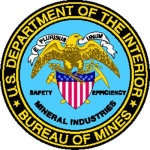- 行业: Mining
- Number of terms: 33118
- Number of blossaries: 0
- Company Profile:
The U.S. Bureau of Mines (USBM) was the primary United States Government agency conducting scientific research and disseminating information on the extraction, processing, use, and conservation of mineral resources.
Founded on May 16, 1910, through the Organic Act (Public Law 179), USBM's missions ...
A process by which igneous rock intrudes, or an orebody is formed in older rocks.
Industry:Mining
A process by which impure blister copper is exposed to long oxidizing heating below fusion point.
Industry:Mining
A process by which low-grade ores, slags, or residues from retorts may be treated either for the recovery of zinc alone or for the recovery of zinc, lead, and tin. It employs a rotary kiln, and the zinc-bearing material mixed with fine coal is fed into the kiln and heated, so that the zinc is vaporized and converted to oxide fume.
Industry:Mining
A process by which magma eats into its roof by engulfing relatively small isolated blocks, which presumably sink to depth where they are assimilated.
Industry:Mining
A process by which material contributing to coal formation responds to diagenetic and metamorphic agencies of coalification and becomes a part of the coal without undergoing any material modification.
Industry:Mining
A process developed by the U.S. Bureau of Mines in which a hot solution of potassium carbonate is used to absorb impurities from gases and is then regenerated for reuse in a continuous cycle with maximum efficiency and minimum wasted heat.
Industry:Mining
A process developed by the U.S. Bureau of Mines in which a hot solution of potassium carbonate is used to absorb impurities from gases and is then regenerated for reuse in a continuous cycle with maximum efficiency and minimum wasted heat.
Industry:Mining
A process developed by the U.S. Bureau of Mines in which a hot solution of potassium carbonate is used to absorb impurities from gases and is then regenerated for reuse in a continuous cycle with maximum efficiency and minimum wasted heat.
Industry:Mining
A process evolved for dealing with pyrite roasting residues rich in zinc (8% to 10%). The direct reduction takes place in a short rotary drum that has a rammed tar-dolomite lining. Lime is added to produce a highly basic slag; the pyrite cinders, precalcined, are mixed with coke breeze and fired with pulverized coal burners. The zinc is recovered from the waste gases. The drum works discontinuously in 7-h heats, and the capacity of such a plant is limited in comparison with a blast furnace. The product is a liquid pig iron.
Industry:Mining
A process for converting beryl to beryllium oxide by sintering a mixture of beryl, soda ash, sodium silicofluoride, and sodium ferric fluoride, leaching with hot water, and adding caustic soda to precipitate beryllium hydroxide, which is calcined to beryllia.
Industry:Mining
